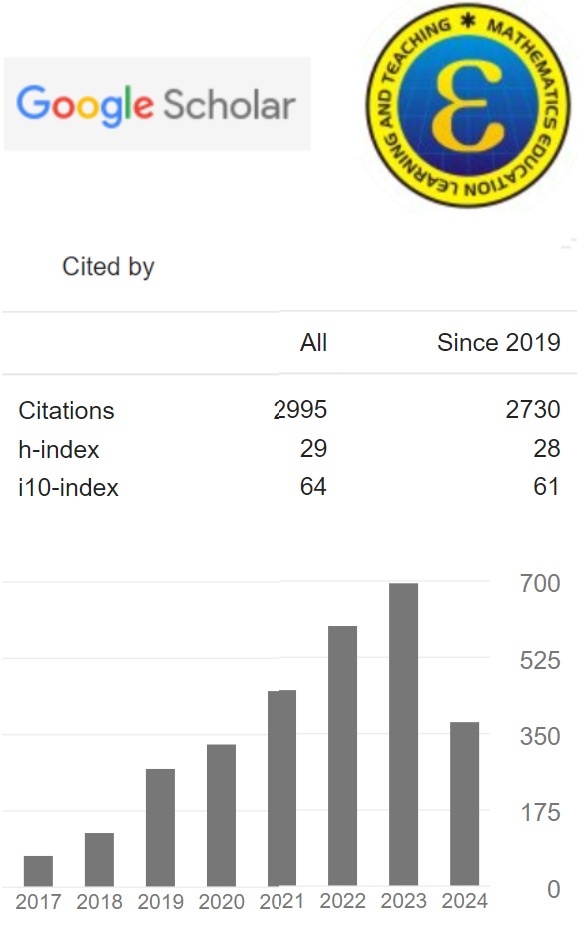The Effect of Cooperative Learning Type Team Assisted Individualization Assisted by Teaching Aids on Students' Mathematical Representation Ability
(1) SMP Negeri 30 Batam
(2) SMP IT Imam Syafi’i Batam
(3) SMP Negeri 42 Batam
(*) Corresponding Author
Abstract
Keywords
Full Text:
PDFReferences
Ary, D., Jacobs, L. C., & Razavieh, A. (2010). Introduction to research in education 8th edition, Wardswoth Cengage Learning. Canada: Nelson Education Ltd Exotic Classic.
Gagne, E. D. (1985). The cognitive psychology of school learning. Boston: Brown and company.
Habibullah, H., Puspitarani, P., & Prasetyo, H. (2020). Mathematical Self-Efficacy of Students in Cooperative Learning With Two Stay Two Stray Technique. PYTHAGORAS: Jurnal Program Studi Pendidikan Matematika, 9(1), 71-76 http://dx.doi.org/10.23887/jjpm.v11i1.23609
Haylock, D., & Thangata, F. (2007). Key concepts in teaching primary mathematics. London: SAGE Publications.
Hwang, W. Y., Chen, N. S., Dung, J. J., & Yang, Y. L. (2007). Multiple representation skills and creativity effects on mathematical problem solving using a multimedia whiteboard system. Journal of Educational Technology & Society, 10(2), 191-212. Retrived from https://www.jstor.org/stable/10.2307/jeductechsoci.10.2.191
Irvan, M. F., Jerusalem, M. A., & Habibullah. (2020). The mathematics learning model’s for early grade students: Contextual or problem-based learning. AKSIOMA: Jurnal Program Studi Pendidikan Matematika, 9(3), 551–560. https://doi.org/https://doi.org/10.24127/ajpm.v9i3.2779
Jihad, A., & Haris, A. (2010). Evaluasi Pembelajaran. Yogyakarta: Multi Pressindo.
Kartini. (2009). Peranan representasi dalam pembelajaran matematika. In Seminar Nasional Matematika dan Pendidikan Matematika UNY (pp. 361–372).
Kowiyah, & Mulyawati, I. (2018). An Analysis of Primary School Students’ Representational Ability in mathematics based on gender perspective. Journal of Physics: Conference Series, 948(12016), 1–8. https://doi.org/10.1088/1742-6596/948/1/012016
Mayer, R. E. (1992). Thinking, problem solving, cognition. New York: W. H. Freeman and Company
Minarti, E. D., & Senjayawati, E. (2015). Studi Komperatif Penerapan Pendekatan Kontekstual Dan Pendekatan Kontekstual Bersetting Pembelajaran Cooperative Script Terhadap Kemampuan Representasi Matematis dan Self Confidence Siswa Smk Di Kota Cimahi. Jurnal Ilmiah P2M STKIP Siliwangi, 2(2), 169-181. https://doi.org/10.22460/p2m.v2i2p169-181.176
Muhamad, N. (2016). Pengaruh metode discovery learning untuk meningkatkan representasi matematis dan percaya diri siswa. Jurnal Pendidikan Universitas Garut, 9(1), 9–22.Retrived from http://journal.uniga.ac.id/index.php/JP/article/view/83
NCTM. (2000). Principle and standards for school mathematics. Reston, VA: The National Council of Teachers of Mathematics, Inc.
Reys, R., Lindquist, M. M., Lambdin, D. V, & Smith, N. L. (2009). Helping children learn mathematics (9th ed.). New York: John Wiley & Sons, Inc.
Sabirin, M. (2014). Representasi dalam pembelajaran matematika. Jurnal Pendidikan Matematika (JPM) IAIN Antasari, 1(2), 33–44. http://dx.doi.org/10.18592/jpm.v1i2.49
Safrin, Anggo, M., & Sani, A. (2018). Peningkatan Kemampuan Representasi Matematis Siswa SMP Melalui Penerapan Model Pembelajaran Kooperatif Tipe Team Asissted Individualization (TAI) dengan Pendekatan Saintifik. Jurnal Pembelajaran Berpikir Matematika, 3(1), 13–24. http://dx.doi.org/10.33772/jpbm.v3i1.7236
Suprihatiningrum, J. (2013). Strategi pembelajaran: Teori & aplikasi. Yogyakarta: Ar Ruzz Media.
Walle, J. A. Van de. (2007). Elementary and middle school mathematics: Teaching developmentally. Boston: Pearson Education, Inc.
DOI: 10.24235/eduma.v9i2.7259
Article Metrics
Abstract view : 19 timesPDF - 4 times
Refbacks
- There are currently no refbacks.
Copyright (c) 2020


.png)










